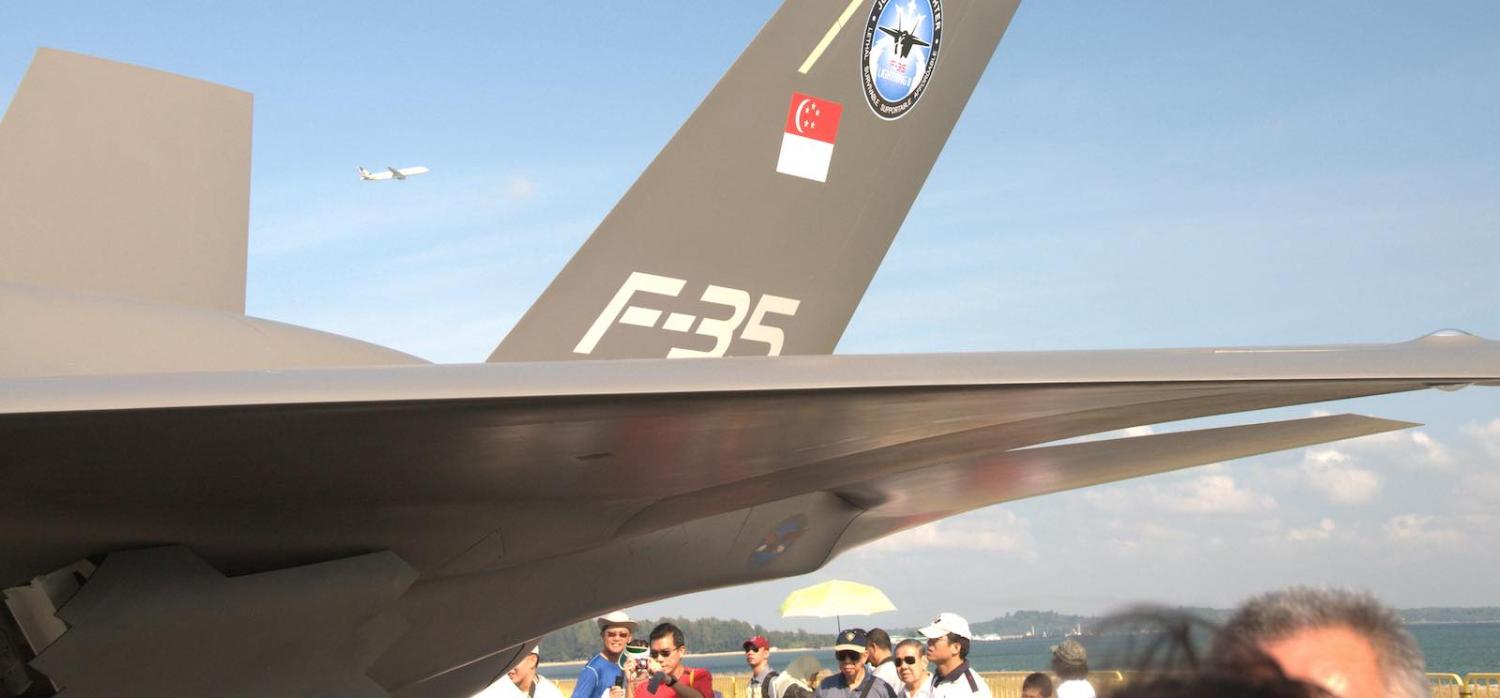Singapore has finally decided to acquire four F-35 aircraft with options for eight more, initially for evaluation purposes. The purchase appears cautious, well-timed, and cost-effective.
Cautious, in that development remains ongoing with a full rate production decision not likely until late 2019. Singapore plans to sign a contract about then.
Well-timed, in that it means Singapore will buy the fully-developed F-35 version, the Lot 15, Block 4 Standard. Any F-35s bought before then will need upgrading to that standard; most of Australia’s F-35s, those delivered and on order, will need upgrading.
And cost-effective, as Singapore will be buying as US annual production rate peaks, usefully pushing acquisition costs down.
The limited numbers and the F-35’s attributes suggest that Singapore will use its new F-35s in combination with its F-16 and F-15 fleets. The attribute of the F-35 that pilots most stress is its excellent sensor package that provides a very detailed picture of the battlespace. The emerging F-35 operating method appears to be F-35s operating forward in hostile airspace using stealth to survive, while passing detailed targeting information back to distant F-16 and F-15 aircraft flying outside heavily defended areas, allowing them to fire their air-to-air and air-to-surface missiles at maximum range. This approach maximises the qualities of the different aircraft involved: the F-35’s stealth and the others’ range and payload capabilities.
In terms of sending a message to an assertive China, the language is mixed. The F-35s limited range means it will not threaten mainland China, although with air-to-air refuelling the fighters could reach China’s new South China Sea airbases.
There is a problem though. The F-35s when in stealthy mode can only datalink to another F-35. But that issue might be addressed by mid-next decade, and there are practical tactical work arounds, even if a bit messy. This issue hints at both opportunities and constraints.
While Singapore will have only limited numbers of F-35s, these can be employed as force multipliers using their advanced sensors to enhance the operational effectiveness of regional air forces (albeit this will require these air forces to have high-quality datalinks). In that regard, Singapore’s F-35s would be well suited to cooperate closely with South Korean, Japanese, Australian, and US forces.
Most ASEAN air forces, however, will have difficulty working directly with Singapore’s F-35s given data link and interoperability issues. Such air forces might operate in the same general area as Singaporean F-35s rather than forming a closely integrated force package. The Singaporean F-35 influence on, and usefulness to, air forces around the South China Sea region seems limited.
In terms of sending a message to an assertive China, the language is mixed. The F-35s limited range means it will not threaten mainland China, although with air-to-air refuelling the fighters could reach China’s new South China Sea airbases. However, given Singapore’s geostrategic location, the country might be less than enthusiastic about joining in a China conflict, instead trying hard to remain neutral.
Such a stance could see the F-35s protecting Singaporean airspace from all comers, a Switzerland of Southeast Asia if you will. Singapore’s F-35s may be more a regional asset than one appropriate to a China contingency.
Such comments aside, in simply military terms, Singapore’s small number of air bases are progressively becoming more vulnerable to attack. China is building an impressive long-range ballistic missile and cruise missile attack capability. The long-runway F-35A version would be quite vulnerable if based in Singapore; the existing protective shelters would be hard placed to stop a ballistic missile attack. This doesn’t just apply to Singaporean F-35s. It is difficult to see US Air Force F-35As operating in Singapore during some time of hypothetical conflict as it would be too risky for too limited a return.
Given these concerns, Singapore could acquire at least some of the short-range/low payload F-35B short takeoff/vertical landing version. As these do not need long runways to operate, they can be better hidden and accordingly better survive missile attack. The F-35Bs could be flown around Singapore as flying senor packages relaying targeting data to ground-based surface-to-air and surface-to-surface missile systems (such as anti-ship missile systems). While the F-35B is rather expensive to buy and operate, in such a niche air defence and air surveillance role it may provide a useful, unique capability.
Singapore’s purchase throws up two issues for Australia.
Firstly, Singapore gradually developing an F-35 operating base on the island will be advantageous to Australia’s F-35 regional deployments, especially for Five Power Defence Arrangement exercises. In that regard, being a flying sensor package, both nation’s F-35s might usefully monitor Chinese aircraft movements around the region in peacetime, or perhaps during a crisis short of war.
This cuts both ways. China will also be assiduously trying to collect information on Singapore’s (and Australia’s) F-35s to help China further improve its stealth aircraft technology and tactics. This geographic vulnerability to intelligence collection also applies to South Korea’s and Japan’s new F-35 fleets.
Secondly, the Singaporean defence minister Ng Eng Hen displayed admirable candour concerning F-35 operating costs. Outside the US Government Accountability Office, that’s rare, Australia for one doesn’t know.
Ng noted the total cost of ownership of a 12 aircraft F-35 buy will be “comparable” to that for Singapore’s initial 12 two-engine, heavy-weight F-15SG buy. That might make replacing each all Singapore’s sixty single-engine, light-weight F-16s with F-35s an expensive business. Singapore’s Air Force might shrink – or perhaps choose to supplement a smaller fleet with Australia’s exciting new “loyal wingman”.

